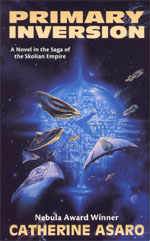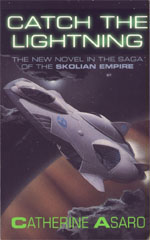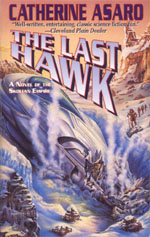 The Ruby Dynasty novels – published by Tor as the Saga of the Skolian Empire – have collectively won the Nebula, the Sapphire, the Prism, and several other awards. It was the Nebula, in particular, awarded to the sixth book in the series (The Quantum Rose), which drew my attention. After reading the cover blurb on Primary Inversion (the first novel in the series), I decided to take a chance. And, since the store also had a used copy of the second novel, Catch the Lightning, I ended up picking up a copy of that, too.
The Ruby Dynasty novels – published by Tor as the Saga of the Skolian Empire – have collectively won the Nebula, the Sapphire, the Prism, and several other awards. It was the Nebula, in particular, awarded to the sixth book in the series (The Quantum Rose), which drew my attention. After reading the cover blurb on Primary Inversion (the first novel in the series), I decided to take a chance. And, since the store also had a used copy of the second novel, Catch the Lightning, I ended up picking up a copy of that, too.
This is a reaction to the first three volumes in the series: Primary Inversion, Catch the Lightning, and The Last Hawk.
To give some brief background for the series (and provide necessary context): Six thousand years ago, an unknown alien species, for reasons unknown, scooped a selection of humanity off of Earth and took them to a distant planet. The aliens eventually abandoned this human settlement (again, for reasons unknown) and disappeared. Salvaging the alien technology left behind, this colony of humanity went out to the stars, looking for their lost home.
They never found it. But their colonies did spread throughout the local region of the galaxy under the banner of the Ruby Empire. Eventually, however, the alien technology they had salvaged began to break down – and they lacked the knowledge to repair it or replace it. The Ruby Empire broke apart, and its colonies reverted to various stages of barbarism.
Then Earth discovered the secrets of interstellar travel for itself and turned its eyes to the stars… only to be surprised by the discovery that other humans had gotten there first.
One other piece of crucial information: When the aliens scooped up a segment of humanity, they had, intentionally or not, ended up with a small community which possessed all of the recessive genes necessary for telepathy. Inevitable inbreeding led to psi powers expressing themselves frequently in the Ruby Empire, and in the barbarous colonies the Empire left behind.
In Asaro’s future, humanity is broken down into three interstellar empires: The Allied Worlds of Earth, the Skolian Empire, and the Trader Empire.
The Skolian Empire is effectively ruled by the Ruby Dynasty, a small family of powerful psi descended from the original Ruby Empire. Known as the Rhon, these psi power the Skol-Net – a psi network which binds their empire together and give their fighter pilots a notable edge over the Trader Empire.
The Trader Empire is ruled by aristocrats. These aristos are the result of genetic tinkering with the Rhon. Although the tinkering was an attempt to strengthen their psi powers, the result was far worse: The aristos are genetically-coded sadists, whose psi-receptors receive pain and transform it into pleasure. They conquer worlds mercilessly, and seek out psi to serve them as “providers” (tortured slaves whose ability to project pain greatly increases aristo pleasure).
The Allied Worlds of Earth maintain their existence by virtue of the fact that they could tip the balance of power in the conflict between the Skolians and the Traders. Neither side of the war can afford to antagonize the Allieds.
PRIMARY INVERSION
Asaro’s first novel is packed full of great stuff. At first glance, the plot is well-done space opera of the best sort: Dramatic space battles, larger-than-life characters, planets to be saved, empires to save and empires to thwart.
But as the book develops, surprising depth and detail begin to emerge.
The space battles and interstellar empires are given a firm foundation of hard SF drawn from the cutting-edge of scientific theory: Everything from FTL to space fighters are thoroughly justified. Her larger-than-life characters are given biotech, nano-nets, and cybernetics. Even her planet destroyers are freshly original, thoroughly detailed, and – as a result – thoroughly horrifying in their conception.
And Asaro doesn’t stop there. In addition to her Big Ideas, she also liberally spreads neat ideas all over her universe. The result of all this is a richly textured backdrop against which her action plays out.
Even Asaro’s plot, however, is revealed to have a greater depth than a first glance would reveal: A space opera adventure is quickly shown to be laced by the drama of the characters who participate in it. Romance and heartbreak arise naturally out of Asaro’s strong characterization and active plotting.
Primary Inversion is not, however, without its flaws. Asaro’s ending seems rushed and arbitrary (although it still provides a satisfactory conclusion). The central romance is literally justified through Rhon hormones, instead of arising naturally from circumstance and character.
But these flaws are minor. Primary Inversion is a great read and a ton of fun, and for a first novel it demonstrates a remarkable mastery. I was hooked. I wanted to immediately run back to the store and pick up the rest of the series.
But I had Catch the Lightning already in hand, so I went to that first.
CATCH THE LIGHTNING
 Unfortunately, Catch the Lightning was a major let-down.
Unfortunately, Catch the Lightning was a major let-down.
First off, the hard SF and space opera of Primary Inversion has been flushed for an incredibly stupid alternate universe. Asaro literally tries to convince us that delaying the birth of Jesus Christ and the appearance of monotheism by 340 years would essentially have little or no impact on the modern world. If it hadn’t been for the remarkable strength of Primary Inversion, this would have been a “throw the book against the wall” moment.
The strong, natural plotting of Primary Inversion has also disappeared, to be replaced by deus ex machina after deus ex machina. “Oh, no! The government has taken my boyfriend’s spaceship! It’s a good thing that the mother of my best friend’s roommate works at the top secret facility where my boyfriend’s spaceship has been taken!” (This, by the way, would qualify as yet another “throw the book against the wall” moment.)
Although remnants of the strong, deep characterization remain (notably in the two main characters), most of the cast is populated by poorly rendered clichés. You can always tell who the bad guys are, for example, because they’ll be the ones raping (or trying to rape) the main characters. And even the main characters ring false: The main character is an orphaned teen on the streets of 20th century Los Angeles, yet she has absolutely no problem traveling to the future and engaging in space opera adventures. (Oh, there’s a couple sentences where she tells us how hard it was to make the adjustment. But that’s not demonstrated in even the slightest degree by what she actually says, thinks, or does.)
Perhaps worst of all, the romance elements which made the first novel so endearing have literally been transformed into softcore porn. In fact, all pretence is discarded: Rhon hormones explicitly drive the main characters together, so that Asaro can gleefully move onto describing condoms, erections, and penetration as quickly as possible.
In short, this is an atrocious book. It fails as science fiction. It fails as romance.
It just… fails.
And the disappointment is all the more bitter because it follows the delightful experience which was Primary Inversion.
Based on the strength of Primary Inversion, however, along with some much-needed advice from rec.arts.sf.written, I decided to give Asaro’s third novel a try.
THE LAST HAWK
 The Last Hawk reads to me like a strange, mutant blending between Iain Banks’ The Player of Games and all the worst clichés and flaws which began cropping up in Catch the Lightning. The plot strands a Rhon prince on a relatively primitive world. While being held as a secret political captive for various reasons, the prince engages in a somewhat interesting romp of sex, politics, and gambling.
The Last Hawk reads to me like a strange, mutant blending between Iain Banks’ The Player of Games and all the worst clichés and flaws which began cropping up in Catch the Lightning. The plot strands a Rhon prince on a relatively primitive world. While being held as a secret political captive for various reasons, the prince engages in a somewhat interesting romp of sex, politics, and gambling.
With this book I began to conclude that Asaro simply lacks the skills of a world-builder. She has a lot of neat ideas to throw onto the table, but that’s not the same thing as investing those ideas with believability or making those ideas come together in a coherent fashion. For example, Asaro creates the game of quis: Quis has not only managed to replace warfare on this planet, it has also become the forum for political debate, a repository of lost scientific knowledge, and a way of transmitting messages from one side of the planet to the other (as a result of one player influencing another, who influences another, until the influence reaches the other side of the planet and is then interpreted by someone there).
The problem? Asaro describes quis to us early in the book. It’s essentially a pattern-matching game with a complexity slightly above that of poker. It might have slightly more representational power than Chess, but it comes nowhere near the complexity of Go (even assuming that Asaro is describing to us a simple version of the game). So, basically, Asaro is asking me to believe that Go could replace war, replace talking as a means of conversation and debate, maintain scientific and technological information hidden in its advanced strategies for several millennium, and transmit messages from one side of the planet to the other.
I ain’t buying it.
When Iain Banks told a largely identical story in The Player of Games, the game to which he ascribed such remarkable properties was infinitely more complicated than the simplistic pattern game Asaro describes. (And, in fact, Banks doesn’t ascribe nearly as many ridiculous powers to his game.) As a result, Bank’s story works… and Asaro’s doesn’t.
Did I also mention that this planet is a matriarchy? No? Well, that’s probably because it keeps slipping my mind. The problem is that Asaro’s version of a matriarchy is to essentially take a standard patriarchy and flip-flop the gender roles. In fact, you can take the entire book, flip the genders of the characters, and end up with a perfectly coherent tale. The problem, of course, is that matriarchies don’t work that way. In a society without birth control, for example, females do not become sexually promiscuous while, at the same time, embracing a tradition of warrior leadership. Nor would the concept of “virginal honor” (in the medieval sense) be transferred onto males: They simply lack the physical characteristics required to create such a sense of “honor” being “taken”.
Asaro’s “shortcuts to softcore porn” also take a turn for the worse. No longer content with merely having Rhon hormones justify instant love and eternal commitment, she simply has every single woman with the least hint of sex appeal fall instantly in love with her main character – thus allowing her to quickly segue into pointlessly graphic descriptions of their sex life, before shuffling the female off stage right in order to bring in a brand new love interest from stage left.
What finally killed the book for me, however, were the incessant deus ex machinas. Some of them had become utterly predictable by this point, while others were freshly insipid. For the third straight book, for example, the main character miraculously bumps into someone with a complete set of Rhon genes, but none of the typical recessive deformities. And if you do decide to read this book, make sure to keep an eye on Kelric’s telepathic abilities: Damaged early in the book, they remain turned off whenever they would be inconvenient, but are immediately turned right back on whenever Asaro needs him to read somebody’s mind, only to disappear again in short order when their presence again becomes hindering.
On top of all this, there are quite a few places in the book where Asaro’s plotting is badly telegraphed, and the ending falls apart into a nearly incoherent mess: Scenes without meaning or context begin to be thrown around with wild abandon, jam-packed with coincidences indicative of an author desperately trying to stick to her outline and deadline. And let’s not even discuss the continuity flaws and other authorial oversights. (The main character, for example, leaves his children to die a horrible death by slow poisoning at the end of the book. Not intentionally, but because the author apparently hasn’t realized that that’s what will happen.)
But I’m forced to ask myself this: Would I be judging this book so harshly if it weren’t for the fact that the appallingly bad Catch the Lightning had painted me a roadmap of Asaro’s weaknesses and foibles?
I don’t think so.
But it still isn’t an impressive offering by any stretch of the imagination. Ultimately my reaction to The Last Hawk can be summed up like this: It took me a day and a half to finish the last twenty-five pages of the book. I literally couldn’t muster enough interest in the characters, the plot, or the book to keep my attention focused for more than a couple of minutes at a time.
CONCLUSIONS
All of this leaves me, once again, in a quandary. Do I keep dipping my toes into this pool, hoping that the lightning which struck with Primary Inversions will find Catherine Asaro again? I ended up picking up a copy of The Quantum Rose the day before I started The Last Hawk, because it was used and cheap. But there are still two more volumes between The Last Hawk and The Quantum Rose. So… I dunno. Maybe. There’s still enough there to convince me that Asaro has the stuff it takes to make a good (possibly even great) author. And there’s that Nebula award for The Quantum Rose, which is what intrigued me into trying the series in the first place.
But, at the very least, it will be awhile before I do: There’s other stuff I want to read.
GRADES:
PRIMARY INVERSION: A-
CATCH THE LIGHTNING: F
THE LAST HAWK: C
Catherine Asaro
Published: 1995/1996/1997
Publisher: Tor
Cover Price: $6.99
ISBNs: 0-812-55023-4 / 0-812-55102-8 / 0-812-55110-9
Buy Now!












